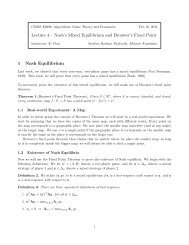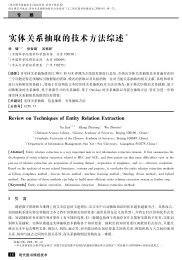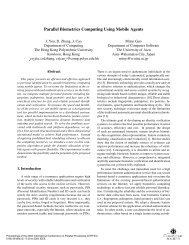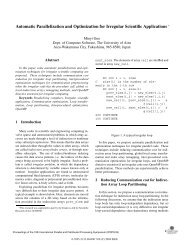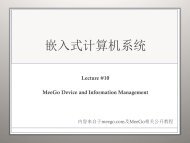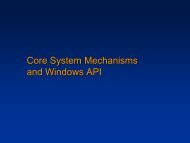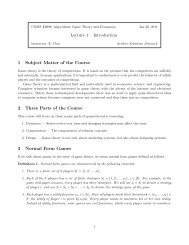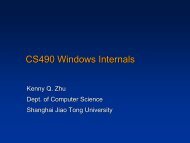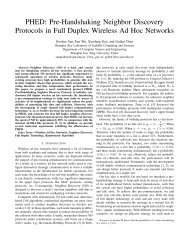Dispatcher Objects
Dispatcher Objects
Dispatcher Objects
You also want an ePaper? Increase the reach of your titles
YUMPU automatically turns print PDFs into web optimized ePapers that Google loves.
1Concurrency (II)--- Synchronization
2Road Map For This LectureSynchronization in Windows & LinuxHigh-IRQL Synchronization (spin locks)Low-IRQL Synchronization (dispatcher objects)Windows APIs for synchronization
3Windows SynchronizationUses interrupt masks to protect access to globalresources on uniprocessor systems (by raising orlowering IRQLs).Uses spinlocks on multiprocessor systems.Provides dispatcher objects which may act as mutexesand semaphores.<strong>Dispatcher</strong> objects may also provide events. An eventacts much like a condition variable.
4Linux SynchronizationKernel disables interrupts for synchronizing access toglobal data on uniprocessor systems.Uses spinlocks for multiprocessor synchronization.Uses semaphores and readers-writers locks whenlonger sections of code need access to data.Implements POSIX synchronization primitives to supportmultitasking, multithreading (including real-time threads),and multiprocessing.
5High-IRQL SynchronizationSynchronization on MP systems use spinlocks to coordinate among theprocessorsSpinlock acquisition and release routines implement a one-owner-at-a-timealgorithmA spinlock is either free, or is considered to be owned by a CPUAnalogous to using Windows API mutexes from user modeA spinlock is just a data cell in memoryAccessed with a test-and-set operation that is atomic across all processors31KSPIN_LOCK is an opaque data type, typedef’d as a ULONGTo implement synchronization, a single bit is sufficient0
6Using a spinlockProcessor A...Processor B...doacquire_spinlock(DPC)until (SUCCESS)spinlockdoacquire_spinlock(DPC)until (SUCCESS)beginremove DPC from queueendDPCDPCbeginremove DPC from queueendrelease_spinlock(DPC)release_spinlock(DPC)Critical sectionA spinlock is a locking primitive associatedwith a global data structure, such as the DPC queue
7Spinlocks in ActionCPU 1 CPU 2Try to acquire spinlock:Test, set, WAS CLEAR(got the spinlock!)Begin updating datathat’s protected by thespinlock(done with update)Release the spinlock:Clear the spinlock bitTry to acquire spinlock:Test, set, was set, loopTest, set, was set, loopTest, set, was set, loopTest, set, was set, loopTest, set, WAS CLEAR(got the spinlock!)Begin updating data
8Queued SpinlocksProblem: Checking status of spinlock via test-and-setoperation creates bus contentionQueued spinlocks maintain queue of waiting processorsFirst processor acquires lock; other processors wait onprocessor-local flagThus, busy-wait loop requires no access to the memory busWhen releasing lock, the first processor’s flag is modifiedExactly one processor is being signaledPre-determined wait order
9SMP Scalability ImprovementsWindows 2000: queued spinlocksXP/2003:!qlocks in Kernel DebuggerMinimized lock contention for hot locks (PFN or Page Frame Database) lockSome locks completely eliminatedCharging nonpaged/paged pool quotas, allocating and mapping system page tableentries, charging commitment of pages, allocating/mapping physical memorythrough AWE functionsNew, more efficient locking mechanism (pushlocks)Server 2003:Doesn’t use spinlocks when no contentionSmaller size than mutex or semaphore (4 bytes on 32-bit systems)Used for object manager and address windowing extensions (AWE) related locksMore spinlocks eliminated (context swap, system space, commit)Further reduction of use of spinlocks & length they are heldScheduling database now per-CPUAllows thread state transitions in parallel
10Low-IRQL SynchronizationKernel mode:Kernel dispatcher objectsFast mutexes and guarded mutexesExecutive resourcesPushlocksUser mode:Condition variablesSlim read-write locksRun once initializationCritical sections
11WaitingFlexible wait callsWait for one or multiple objects in one callWait for multiple can wait for “any” one or “all” at once“All”: all objects must be in the signalled state concurrently to resolve the waitAll wait calls include optional timeout argumentWaiting threads consume no CPU timeWaitable objects include:Events (may be auto-reset or manual reset; may be set or “pulsed”)Mutexes (“mutual exclusion”, one-at-a-time)Semaphores (n-at-a-time)TimersProcesses and Threads (signaled upon exit or terminate)Directories (change notification)No guaranteed ordering of wait resolutionIf multiple threads are waiting for an object, and only one thread is released (e.g. it’s amutex or auto-reset event), which thread gets released is unpredictableTypical order of wait resolution is FIFO; however APC delivery may change this order
12Executive SynchronizationWaiting on <strong>Dispatcher</strong> <strong>Objects</strong> – outside the kernelCreate and initialize thread objectTerminatedThread waitson an objecthandleInitializedWaitingWait is complete;Set object tosignaled stateReadyRunningTransitionStandbyInteraction with thread scheduling
13Interactions betweenSynchronization and ThreadDispatching1. User mode thread waits on an event object‘s handle2. Kernel changes thread‘s scheduling state from ready to waiting andadds thread to wait-list3. Another thread sets the event4. Kernel wakes up waiting threads; variable priority threads get priorityboost5. <strong>Dispatcher</strong> re-schedules new thread – it may preempt running threadif it has lower priority and issues software interrupt to initiate contextswitch6. If no processor can be preempted, the dispatcher places the readythread in the dispatcher ready queue to be scheduled later
14What signals an object?<strong>Dispatcher</strong>objectSystem eventsand resultingstate changeOwning thread releases mutexEffect of signaled stateon waiting threadsMutex (kernel mode)Mutex(exported to user mode)SemaphorenonsignalednonsignalednonsignaledsignaledResumed thread acquires mutexOwning thread or otherthread releases mutexsignaledResumed thread acquires mutexOne thread releases thesemaphore, freeing a resourcesignaledA thread acquires the semaphore.More resources are not availableKernel resumes onewaiting threadKernel resumes onewaiting threadKernel resumes oneor more waiting threads
15What signals an object? (contd.)<strong>Dispatcher</strong> objectSystem events and resultingstate changeEffect of signaled stateon waiting threadsEventnonsignaledA thread sets the eventKernel resumes oneor more threadssignaledKernel resumes oneor more waiting threadsEvent pairnonsignaledDedicated thread sets oneevent in the event pairKernel resumes theother dedicated threadsignaledKernel resumes waitingdedicated threadTimer expiresTimernonsignaledsignaledKernel resumes allwaiting threadsA thread (re) initializes the timer
16What signals an object? (contd.)<strong>Dispatcher</strong> objectSystem events and resultingstate changeEffect of signaled stateon waiting threadsIO operation completesFilenonsignaledThread initiates waiton an IO portsignaledKernel resumes waitingdedicated threadProcessnonsignaledProcess terminatessignaledKernel resumes allwaiting threadsA process reinitializesthe process objectThreadnonsignaledThread terminatesA thread reinitializesthe thread objectsignaledKernel resumes allwaiting threads
17Wait Internals 1:<strong>Dispatcher</strong> <strong>Objects</strong>Any kernel object you can wait for is a “dispatcher object”some exclusively for synchronizatione.g. events, mutexes (“mutants”), semaphores, queues, timersothers can be waited for as a side effect of their prime functione.g. processes, threads, file objectsnon-waitable kernel objects are called “control objects”All dispatcher objects have a common headerAll dispatcher objects are in one of two states“signaled” vs. “nonsignaled”when signalled, a wait on the object is satisfieddifferent object types differ in terms of what changestheir statewait and unwait implementation iscommon to all types of dispatcher objects<strong>Dispatcher</strong>ObjectSize TypeStateWait list headObject-typespecificdata(see \ntddk\inc\ddk\ntddk.h)
18Thread 1WaitBlockList<strong>Dispatcher</strong><strong>Objects</strong>Size TypeStateThread objectsThread 2WaitBlockListWait blocksWait Internals 2:Wait BlocksRepresent a thread’s reference tosomething it’s waiting for (one per handlepassed to WaitFor…)All wait blocks from a given wait call arechained to the waiting threadType indicates wait for “any” or “all”Key denotes argument list position forWaitForMultiple<strong>Objects</strong>Wait listheadObject-typespecificdataList entryThreadObjectKey TypeNext linkSize TypeStateWait listheadObject-typespecificdataList entryThreadObjectKey TypeNext linkList entryThreadObjectKey TypeNext link
19Windows APIs for SynchronizationWindows API constructs for synchronization andinterprocess communicationSynchronizationCritical sectionsMutexesSemaphoresEvent objectsSynchronization through inter-process communicationAnonymous pipesNamed pipesMailslots
20Critical SectionsVOID InitializeCriticalSection( LPCRITICAL_SECTION sec );VOID DeleteCriticalSection( LPCRITICAL_SECTION sec );VOID EnterCriticalSection( LPCRITICAL_SECTION sec );VOID LeaveCriticalSection( LPCRITICAL_SECTION sec );BOOL TryEnterCriticalSection ( LPCRITICAL_SECTION sec );Only usable from within the same processCritical sections are initialized and deleted but do not have handlesOnly one thread at a time can be in a critical sectionA thread can enter a critical section multiple times - however, thenumber of Enter- and Leave-operations must matchLeaving a critical section before entering it may cause deadlocksNo way to test whether another thread is in a critical section
21Critical Section Example/* counter is global, shared by all threads */volatile int counter = 0;CRITICAL_SECTION crit;InitializeCriticalSection ( &crit );/* … main loop in any of the threads */while (!done) {_try {EnterCriticalSection ( &crit );counter += local_value;LeaveCriticalSection ( &crit );}_finally { LeaveCriticalSection ( &crit ); }}DeleteCriticalSection( &crit );
22Synchronizing Threads withKernel <strong>Objects</strong>DWORD WaitForSingleObject( HANDLE hObject, DWORD dwTimeout );DWORD WaitForMultiple<strong>Objects</strong>( DWORD c<strong>Objects</strong>,LPHANDLE lpHandles, BOOL bWaitAll,DWORD dwTimeout );The following kernel objects can be usedto synchronize threads:ProcessesThreadsJobsFilesConsole inputFile change notificationsMutexesSemaphorsEvents (auto-reset + manual-reset)Waitable timers
23Wait Functions - DetailsWaitForSingleObject():hObject specifies kernel objectdwTimeout specifies wait time in msecdwTimeout == 0 - no wait, check whether object is signaleddwTimeout == INFINITE - wait foreverWaitForMultiple<strong>Objects</strong>():c<strong>Objects</strong>
MutexesHANDLE CreateMutex( LPSECURITY_ATTRIBUTE lpsa,BOOL fInitialOwner, LPTSTR lpszMutexName );HANDLE OpenMutex( LPSECURITY_ATTRIBUTE lpsa,BOOL fInitialOwner, LPTSTR lpszMutexName );BOOL ReleaseMutex( HANDLE hMutex );Mutexes work across processesFirst thread has to call CreateMutex()When sharing a mutex, second thread (process) calls CreateMutex()or OpenMutex()fInitialOwner == TRUE gives creator immediate ownershipThreads acquire mutex ownership using WaitForSingleObject() orWaitForMultiple<strong>Objects</strong>()ReleaseMutex() gives up ownershipCloseHandle() will free mutex object24
25Mutex Example/* counter is global, shared by all threads */volatile int done, counter = 0;HANDLE mutex = CreateMutex( NULL, FALSE, NULL );/* main loop in any of the threads, ret is local */DWORD ret;while (!done) {ret = WaitForSingleObject( mutex, INFINITE );if (ret == WAIT_OBJECT_0)counter += local_value;else /* mutex was abandoned */break; /* exit the loop */ReleaseMutex( mutex );}CloseHandle( mutex );
26Comparison - POSIX mutexesPOSIX pthreads specification supports mutexesSynchronization among threads in same processFive basic functions:pthread_mutex_init()pthread_mutex_destroy()pthread_mutex_lock()pthread_mutex_unlock()pthread_mutex_trylock()Comparison:pthread_mutex_lock() will block - equivalent toWaitForSingleObject( hMutex );pthread_mutex_trylock() is nonblocking (polling) - equivalent toWaitForSingleObject() with timeout == 0
27SemaphoresHANDLE CreateSemaphore( LPSECURITY_ATTRIBUTE lpsa,LONG cSemInit, LONG cSemMax,LPTSTR lpszSemName );HANDLE OpenSemaphore( LPSECURITY_ATTRIBUTE lpsa,LONG cSemInit, LONG cSemMax,LPTSTR lpszSemName );HANDLE ReleaseSemaphore( HANDLE hSemaphore,LONG cReleaseCount, LPLONG lpPreviousCount );Semaphore objects are used for resource countingA semaphore is signaled when count > 0Threads/processes use wait functionsEach wait function decreases semaphore count by 1ReleaseSemaphore() may increment count by any valueReleaseSemaphore() returns old semaphore count
EventsHANDLE CreateEvent( LPSECURITY_ATTRIBUTE lpsa,BOOL fManualReset, BOOL fInititalStateLPTSTR lpszEventName );BOOL SetEvent( HANDLE hEvent );BOOL ResetEvent( HANDLE hEvent );BOOL PulseEvent( HANDLE hEvent );Multiple threads can be released when a single event is signaled(barrier synchronization)Manual-reset event can signal several thread simultaneously; mustbe reset manuallySetEvent sets the event object to be signaledResetEvent sets of the event object to be unsignaledPulseEvent() will release all threads waiting on a manual-reset eventand automatically reset the eventAuto-reset event signals a single thread; event is reset automaticallyfInitialState == TRUE - create event in signaled state28
29Comparison -POSIX condition variablespthread’s condition variables are comparable to eventspthread_cond_init()pthread_cond_destroy()Wait functions:pthread_cond_wait()pthread_cond_timedwait()Signaling:pthread_cond_signal() - one threadpthread_cond_broadcast() - all waiting threadsNo exact equivalent to manual-reset events
30Anonymous pipesBOOL CreatePipe( PHANDLE phRead,PHANDLE phWrite,LPSECURITY_ATTRIBUTES lpsa,DWORD cbPipe )Half-duplex character-based IPCcbPipe: pipe byte size; zero == defaultRead on pipe handle will block if pipe is emptyWrite operation to a full pipe will blockAnonymous pipes are one-way (half-duplex)mainprog1pipeprog2
31I/O Redirection usingan Anonymous Pipe/* Create default size anonymous pipe, handles are inheritable. */if (!CreatePipe (&hReadPipe, &hWritePipe, &PipeSA, 0)) {fprintf(stderr, “Anon pipe create failed\n”); exit(1);}/* Set output handle to pipe handle, create first processes. */StartInfoCh1.hStdInput = GetStdHandle (STD_INPUT_HANDLE);StartInfoCh1.hStdError = GetStdHandle (STD_ERROR_HANDLE);StartInfoCh1.hStdOutput = hWritePipe;StartInfoCh1.dwFlags = STARTF_USESTDHANDLES;if (!CreateProcess (NULL, (LPTSTR)Command1, NULL, NULL, TRUE,0, NULL, NULL, &StartInfoCh1, &ProcInfo1)) {}fprintf(stderr, “CreateProc1 failed\n”); exit(2);CloseHandle (hWritePipe);
32Pipe example (contd.)/* Repeat (symmetrically) for the second process. */StartInfoCh2.hStdInput = hReadPipe;StartInfoCh2.hStdError = GetStdHandle (STD_ERROR_HANDLE);StartInfoCh2.hStdOutput = GetStdHandle (STD_OUTPUT_HANDLE);StartInfoCh2.dwFlags = STARTF_USESTDHANDLES;if (!CreateProcess (NULL, (LPTSTR)targv, NULL, NULL,TRUE,/* Inherithandles. */}0, NULL, NULL, &StartInfoCh2, &ProcInfo2)) {fprintf(stderr, “CreateProc2 failed\n”); exit(3);CloseHandle (hReadPipe);/* Wait for both processes to complete. */WaitForSingleObject (ProcInfo1.hProcess, INFINITE);WaitForSingleObject (ProcInfo2.hProcess, INFINITE);CloseHandle (ProcInfo1.hThread); CloseHandle (ProcInfo1.hProcess);CloseHandle (ProcInfo2.hThread); CloseHandle (ProcInfo2.hProcess);return 0;
33Named PipesMessage oriented:Reading process can read varying-length messages precisely assent by the writing processBi-directionalTwo processes can exchange messages over the same pipeMultiple, independent instances of a named pipe:Several clients can communicate with a single serverusing the same instanceServer can respond to client using the same instancePipe can be accessed over the networklocation transparencyConvenience and connection functions
34Using Named PipesHANDLE CreateNamedPipe (LPCTSTR lpszPipeName,DWORD fdwOpenMode, DWORD fdwPipModeDWORD nMaxInstances, DWORD cbOutBuf,DWORD cbInBuf, DWORD dwTimeOut,LPSECURITY_ATTRIBUTES lpsa );lpszPipeName: \\.\pipe\[path]pipenameNot possible to create a pipe on remote machine (. – local machine)fdwOpenMode:PIPE_ACCESS_DUPLEX, PIPE_ACCESS_INBOUND,PIPE_ACCESS_OUTBOUNDfdwPipeMode:Use same flag settings forall instances of a named pipePIPE_TYPE_BYTE or PIPE_TYPE_MESSAGEPIPE_READMODE_BYTE or PIPE_READMODE_MESSAGEPIPE_WAIT or PIPE_NOWAIT (will ReadFile block?)
35Named Pipes (contd.)nMaxInstances:Number of instances,PIPE_UNLIMITED_INSTANCES: OS choice based on resourcesdwTimeOutDefault time-out period (in msec) for WaitNamedPipe()First CreateNamedPipe creates named pipeClosing handle to last instance deletes named pipePolling a pipe:Nondestructive – is there a message waiting for ReadFileBOOL PeekNamedPipe (HANDLE hPipe,LPVOID lpvBuffer, DWORD cbBuffer,LPDWORD lpcbRead, LPDWORD lpcbAvail,LPDWORD lpcbMessage);
36Named Pipe Client ConnectionsCreateFile with named pipe name:\\.\pipe\[path]pipename\\servername\pipe\[path]pipenameFirst method gives better performance (local server)Status Functions:GetNamedPipeHandleStateSetNamedPipeHandleStateGetNamedPipeInfo
37Convenience FunctionsWriteFile / ReadFile sequence:BOOL TransactNamedPipe( HANDLE hNamedPipe,LPVOID lpvWriteBuf, DWORD cbWriteBuf,LPVOID lpvReadBuf, DWORD cbReadBuf,LPDOWRD lpcbRead, LPOVERLAPPED lpa);• CreateFile / WriteFile / ReadFile / CloseHandle:- dwTimeOut: NMPWAIT_NOWAIT, NMPWAIT_WIAT_FOREVER,NMPWAIT_USE_DEFAULT_WAITBOOL CallNamedPipe( LPCTSTR lpszPipeName,LPVOID lpvWriteBuf, DWORD cbWriteBuf,LPVOID lpvReadBuf, DWORD cbReadBuf,LPDWORD lpcbRead, DWORD dwTimeOut);
38Server: eliminate the polling loopBOOL ConnectNamedPipe (HANDLE hNamedPipe,LPOVERLAPPED lpo );lpo == NULL:Call will return as soon as there is a client connectionReturns false if client connected between CreateNamed Pipe calland ConnectNamedPipe()Use DisconnectNamedPipe to free the handle for connection fromanother clientWaitNamedPipe():Client may wait for server’s named pipe name (string)Security rights for named pipes:GENERIC_READ, GENERIC_WRITE, SYNCHRONIZE
39Comparison with UNIXUNIX FIFOs are similar to a named pipeFIFOs are half-duplexFIFOs are limited to a single machineFIFOs are still byte-oriented, so its easiest to use fixed-size recordsin client/server applicationsIndividual read/writes are atomicA server using FIFOs must use a separate FIFO for each client’sresponse, although all clients can send requests via a single, wellknown FIFOMkfifo() is the UNIX counterpart to CreateNamedPipe()Use sockets for networked client/server scenarios
40Client Example using Named PipeWaitNamedPipe (ServerPipeName, NMPWAIT_WAIT_FOREVER);hNamedPipe = CreateFile (ServerPipeName, GENERIC_READ | GENERIC_WRITE,0, NULL, OPEN_EXISTING, FILE_ATTRIBUTE_NORMAL, NULL);if (hNamedPipe == INVALID_HANDLE_VALUE) {fptinf(stderr, Failure to locate server.\n"); exit(3);}/* Write the request. */WriteFile (hNamedPipe, &Request, MAX_RQRS_LEN, &nWrite, NULL);/* Read each response and send it to std out. */while (ReadFile (hNamedPipe, Response.Record, MAX_RQRS_LEN, &nRead, NULL))printf ("%s", Response.Record);CloseHandle (hNamedPipe);return 0;
41Server Example Using a NamedPipehNamedPipe = CreateNamedPipe (SERVER_PIPE_NAME, PIPE_ACCESS_DUPLEX,PIPE_READMODE_MESSAGE | PIPE_TYPE_MESSAGE | PIPE_WAIT,1, 0, 0, CS_TIMEOUT, pNPSA);while (!Done) {printf ("Server is awaiting next request.\n");if (!ConnectNamedPipe (hNamedPipe, NULL)|| !ReadFile (hNamedPipe, &Request, RQ_SIZE, &nXfer, NULL)) {fprintf(stderr, “Connect or Read Named Pipe error\n”); exit(4);}printf( “Request is: %s\n", Request.Record);/* Send the file, one line at a time, to the client. */fp = fopen (File, "r");while ((fgets (Response.Record, MAX_RQRS_LEN, fp) != NULL))WriteFile (hNamedPipe, &Response.Record,(strlen(Response.Record) + 1) * TSIZE, &nXfer, NULL);fclose (fp);DisconnectNamedPipe (hNamedPipe);} /* End of server operation. */
42Windows IPC - MailslotsBroadcast mechanism:One-directionalMultiple writers/multiple readers (frequently: one-to-many comm.)Message delivery is unreliableCan be located over a network domainMessage lengths are limited (< 424 bytes)Operations on the mailslot:Each reader (server) creates mailslot with CreateMailslot()Write-only client opens mailslot with CreateFile() anduses WriteFile() – open will fail if there are no waiting readersClient‘s message can be read by all servers (readers)Client lookup: \\*\mailslot\mailslotnameClient will connect to every server in network domainMailslots bear some nastyimplementation details;they are almost never used
43Locate a server via mailslotMailslot ServersApp client 0hMS = CreateMailslot(“\\.\mailslot\status“);ReadFile(hMS, &ServStat);/* connect to server */App client nhMS = CreateMailslot(“\\.\mailslot\status“);ReadFile(hMS, &ServStat);/* connect to server */Message issent periodicallyMailslot ClientApp ServerWhile (...) {Sleep(...);hMS = CreateFile(“\\.\mailslot\status“);...WriteFile(hMS, &StatInfo}
44Creating a mailslotlpszName points to a name of the form\\.\mailslot\[path]nameName must be unique; mailslot is created locallycbMaxMsg is msg size in bytedwReadTimeoutHANDLE CreateMailslot(LPCTSTR lpszName,DWORD cbMaxMsg,DWORD dwReadTimeout,LPSECURITY_ATTRIBUTES lpsa);Read operation will wait for so many msec0 – immediate returnMAILSLOT_WAIT_FOREVER – infinite wait
45Opening a mailslotCreateFile with the following names:\\.\mailslot\[path]name - retrieve handle for local mailslot\\host\mailslot\[path]name - retrieve handlefor mailslot on specified host\\domain\mailslot\[path]name - returns handle representing allmailslots on machines in the domain\\*\mailslot\[path]name - returns handle representing mailslotson machines in the system‘s primary domain: max mesg. len:400 bytesClient must specifiy FILE_SHARE_READ flagGetMailslotInfo() and SetMailslotInfo() are similar to theirnamed pipe counterparts
46Lab: Viewing Global QueuedSpinlockskd> !qlocks Key: O = Owner,1-n = Waitorder, blank = notowned/waiting, C= CorruptProcessor NumberLockName 0 1 2 3 4 5 6 7 8 9 10 11 12 13 14 15KE-<strong>Dispatcher</strong> OKE-ContextSwapMM-PFNMM-SystemSpaceCC-VacbCC– Master
47Lab: Looking at Waiting ThreadsFor waiting threads, user-mode utilities only display the wait reasonExample: pstatTo find out what a thread is waiting on, must use kernel debugger
48Further ReadingMark E. Russinovich, et al. Windows Internals, 5th Edition, Microsoft Press, 2009.Synchronization (from pp.170-198)Named Pipes and Mailslots (from pp. 1021)Ben-Ari, M., Principles of Concurrent Programming, Prentice Hall, 1982Lamport, L., The Mutual Exclusion Problem, Journal of the ACM, April 1986Abraham Silberschatz, Peter B. Galvin, Operating System Concepts, John Wiley &Sons, 6th Ed., 2003;Chapter 7 - Process SynchronizationChapter 8 - DeadlocksJeffrey Richter, Programming Applications for Microsoft Windows, 4th Edition,Microsoft Press, September 1999.Chapter 10 - Thread SynchronizationCritical Sections, Mutexes, Semaphores, Events (from pp. 315)Johnson M. Hart, Win32 System Programming: A Windows® 2000 ApplicationDeveloper's Guide, 2nd Edition, Addison-Wesley, 2000.
49Source Code ReferencesWindows Research Kernel sources\base\ntos\ke – primitive kernel supporteventobj.c - Event objectmutntobj.c – Mutex objectsemphobj.c – Semaphore objecttimerobj.c, timersup.c – Timerswait.c, waitsup.c – Wait support\base\ntos\ex – executive object (layered on kernel support)Event.c – Event objectMutant.c – Mutex objectSemphore.c – Semaphore objectTimer.c – Timer object\base\ntos\inc\ke.h, ex.h – structure/type definitions




